Compositional Difference and Health Risk Assessment of Polycyclic Aromatic Hydrocarbons over the Coal Spontaneous Combustion Zone
Abstract
1. Introduction
2. Materials and Methods
2.1. Sampling Site Characteristics
- The spontaneous combustion zone (C-zone): there are two main spontaneous combustion zones, which are located in the northeast and southwest of the mining area (sampling sites 1 to 4 and 6 to 9);
- The living zone (L-zone): the living zone is located between the two spontaneous combustion zones, in the middle of the mining area, and it is mainly used for the residence of miners and their families (sampling site 5).
- The non-spontaneous combustion zone (N-zone) represents the other zones away from the mining area (sampling site 10).
2.2. PAH Measurements
2.3. Sampling Pre-Treatment and Extraction
2.4. Health Risk Assessment
3. Results
3.1. Concentration Levels, Compositions and Spatial Variation of PAHs
3.2. Potential Health Risk Assessment of PAHs
4. Discussion
5. Conclusions
Author Contributions
Funding
Institutional Review Board Statement
Informed Consent Statement
Data Availability Statement
Conflicts of Interest
References
- Dat, N.-D.; Chang, M.B. Review on Characteristics of PAHs in Atmosphere, Anthropogenic Sources and Control Technologies. Sci. Total Environ. 2017, 609, 682–693. [Google Scholar] [CrossRef] [PubMed]
- Galarneau, E. Source Specificity and Atmospheric Processing of Airborne PAHs: Implications for Source Apportionment. Atmos. Environ. 2008, 42, 8139–8149. [Google Scholar] [CrossRef]
- Lin, Y.; Ma, Y.; Qiu, X.; Li, R.; Fang, Y.; Wang, J.; Zhu, Y.; Hu, D. Sources, Transformation, and Health Implications of PAHs and Their Nitrated, Hydroxylated, and Oxygenated Derivatives in PM2. 5 in Beijing. J. Geophys. Res. Atmos. 2015, 120, 7219–7228. [Google Scholar] [CrossRef]
- Xin, J.; Gong, C.; Liu, Z.; Cong, Z.; Gao, W.; Song, T.; Pan, Y.; Sun, Y.; Ji, D.; Wang, L. The Observation-based Relationships between PM2. 5 and AOD over China. J. Geophys. Res. Atmos. 2016, 121, 10701–10716. [Google Scholar] [CrossRef]
- Zhang, Y.; Tao, S. Global Atmospheric Emission Inventory of Polycyclic Aromatic Hydrocarbons (PAHs) for 2004. Atmos. Environ. 2009, 43, 812–819. [Google Scholar] [CrossRef]
- Jager, C.; Mutschke, H.; Henning, T.; Huisken, F. From PAHs to Solid Carbon. In PAHs and the Universe; EDP Sciences: Les Ulis, France, 2021; pp. 293–304. ISBN 2-7598-2482-9. [Google Scholar]
- Idowu, O.; Semple, K.T.; Ramadass, K.; O’Connor, W.; Hansbro, P.; Thavamani, P. Beyond the Obvious: Environmental Health Implications of Polar Polycyclic Aromatic Hydrocarbons. Environ. Int. 2019, 123, 543–557. [Google Scholar] [CrossRef]
- Liu, G.; Xin, J.; Wang, X.; Si, R.; Ma, Y.; Wen, T.; Zhao, L.; Zhao, D.; Wang, Y.; Gao, W. Impact of the Coal Banning Zone on Visibility in the Beijing-Tianjin-Hebei Region. Sci. Total Environ. 2019, 692, 402–410. [Google Scholar] [CrossRef]
- Lv, S.; Liu, X.; Li, Z.; Lu, F.; Guo, M.; Liu, M.; Wei, J.; Wu, Z.; Yu, S.; Li, S. Causal Effect of PM1 on Morbidity of Cause-Specific Respiratory Diseases Based on a Negative Control Exposure. Environ. Res. 2023, 216, 114746. [Google Scholar] [CrossRef]
- Si, R.; Xin, J.; Zhang, W.; Li, S.; Wen, T.; Wang, Y.; Ma, Y.; Liu, Z.; Xu, X.; Li, M. Source Apportionment and Health Risk Assessment of Trace Elements in the Heavy Industry Areas of Tangshan, China. Air Qual. Atmos. Health 2019, 12, 1303–1315. [Google Scholar] [CrossRef]
- Wang, S.Y.; Wang, M.Y.; Peng, H.X.; Tian, Y.H.; Guo, H.D.; Wang, J.T.; Yu, H.; Xue, E.C.; Chen, X.; Wang, X.H. Synergism of Cell Adhesion Regulatory Genes and Instant Air Pollutants on Blood Pressure Elevation. Chemosphere 2023, 312, 136992. [Google Scholar] [CrossRef]
- Ghosal, D.; Ghosh, S.; Dutta, T.K.; Ahn, Y. Current State of Knowledge in Microbial Degradation of Polycyclic Aromatic Hydrocarbons (PAHs): A Review. Front. Microbiol. 2016, 7, 1369. [Google Scholar] [CrossRef] [PubMed]
- Haritash, A.K.; Kaushik, C.P. Biodegradation Aspects of Polycyclic Aromatic Hydrocarbons (PAHs): A Review. J. Hazard. Mater. 2009, 169, 1–15. [Google Scholar] [CrossRef] [PubMed]
- Kim, K.-H.; Jahan, S.A.; Kabir, E.; Brown, R.J. A Review of Airborne Polycyclic Aromatic Hydrocarbons (PAHs) and Their Human Health Effects. Environ. Int. 2013, 60, 71–80. [Google Scholar] [CrossRef] [PubMed]
- Wilcke, W. Global Patterns of Polycyclic Aromatic Hydrocarbons (PAHs) in Soil. Geoderma 2007, 141, 157–166. [Google Scholar] [CrossRef]
- Wilcke, W. Synopsis Polycyclic Aromatic Hydrocarbons (PAHs) in Soil—A Review. J. Plant Nutr. Soil Sci. 2000, 163, 229–248. [Google Scholar] [CrossRef]
- Onifade, M.; Genc, B. A Review of Research on Spontaneous Combustion of Coal. Int. J. Min. Sci. Technol. 2020, 30, 303–311. [Google Scholar] [CrossRef]
- Jiang, N.; Zhang, L.P.; Meng, Y.R.; Yu, Y.; Liu, J. Analysis on Influencing Factors of Polycyclic Aromatic Hydrocarbons Formation during Coal Combustion. China Energy Environ. Prot. 2012, 12–14. [Google Scholar] [CrossRef]
- Li, X.D.; Qi, M.F.; You, X.F.; Yan, J.H.; Chi, Y.; Ni, M.J.; Cen, K.F. Study on the Formation of Polycyclic Aromatic Hydrocarbon (PAH) Mechanisms in Bituminous Coal Combustion Process. Proc. CSEE 2002, 22, 128–133. [Google Scholar]
- Wang, H.; Frenklach, M. A Detailed Kinetic Modeling Study of Aromatics Formation in Laminar Premixed Acetylene and Ethylene Flames. Combust. Flame 1997, 110, 173–221. [Google Scholar] [CrossRef]
- Wang, W.; Qin, Y.; Sang, S.; Jiang, B.; Guo, Y.; Zhu, Y.; Fu, X. Partitioning of Minerals and Elements during Preparation of Taixi Coal, China. Fuel 2006, 85, 57–67. [Google Scholar] [CrossRef]
- Wang, J.H.; Chen, B.L. Fire Zone Governance and Monitoring Method Selection and Application in Rujigou Coalmine Area. Coal Geol. China 2021, 33, 81–86. [Google Scholar]
- Mao, Y.B. Research on Hyperspectral Quantitative Remote Sensing Detection of the Rujigou Coal Fire Area in Ningxia. Remote Sens. Nat. Resour. 2010, 85, 69–75. [Google Scholar]
- Huang, D.Q.; Zhao, Y.T.; Xie, Z.Q. The Remote Sensing Survey of Coal Fire in the Rujigou Coal Mine, Ningxia. Geophys. Geochem. Explor. 2007, 31, 41–42+125–126. [Google Scholar]
- Rosema, A.; Guan, H.; Veld, H. Simulation of Spontaneous Combustion, to Study the Causes of Coal Fires in the Rujigou Basin. Fuel 2001, 80, 7–16. [Google Scholar] [CrossRef]
- Huo, H.; Jiang, X.; Song, X.; Li, Z.-L.; Ni, Z.; Gao, C. Detection of Coal Fire Dynamics and Propagation Direction from Multi-Temporal Nighttime Landsat SWIR and TIR Data: A Case Study on the Rujigou Coalfield, Northwest (NW) China. Remote Sens. 2014, 6, 1234–1259. [Google Scholar] [CrossRef]
- Yang, H.; Mao, Z.; Ai, N.; Wu, D. The World’s Best Taixi Coal. Northwest. Geol. 2016, 49, 98. [Google Scholar]
- Wang, B.; Chen, Y.; Zhou, Z. Study of soil nitrogen mineralization at different altitudes on western slopes of Helan Mountains, China. J. Desert Res. 2007, 27, 483–490. [Google Scholar]
- Wang, B.; Zhou, Z.; Zhang, G. Research on the relationship between phosphorus in soil and plant system at different altitudes on the western slope of Helan Mountains. J. Anhui Agric. Sci. 2009, 37, 17630–17634+17674. [Google Scholar] [CrossRef]
- Chen, Z.; Tian, Z.; Liu, X.; Sun, W. The Potential Risks and Exposure of Qinling Giant Pandas to Polycyclic Aromatic Hydrocarbon (PAH) Pollution. Environ. Pollut. 2022, 292, 118294. [Google Scholar] [CrossRef]
- Yang, B.; Liu, S.; Liu, Y.; Li, X.; Lin, X.; Liu, M.; Liu, X. PAHs Uptake and Translocation in Cinnamomum Camphora Leaves from Shanghai, China. Sci. Total Environ. 2017, 574, 358–368. [Google Scholar] [CrossRef]
- Menzie, C.A.; Potocki, B.B.; Santodonato, J. Exposure to Carcinogenic PAHs in the Environment. Environ. Sci. Technol. 1992, 26, 1278–1284. [Google Scholar] [CrossRef]
- Hu, Y.D.; Du, X.H.; Qi, F.Q.; Chen, N. Pollution characteristics, source analysis and population health risk assessment of polycyclic aromatic hydrocarbons in PM2.5 during heating and non-heating periods in an industrial area in Northwest China. Mod. Prev. Med. 2022, 49, 227–235. [Google Scholar]
- NHCPRC. Report on Chinese Residents’ Chronic Diseases and Nutrition; People’s Medical Publishing House: Beijing, China, 2015. [Google Scholar]
- Han, J.B.; Xiao, Y.N.; Liu, C.F.; Han, K. Characteristics and human health risk of polycyclic aromatic hydrocarbons components in fine particle in Baoding, Hebei. J. Saf. Environ. 2020, 20, 1459–1466. [Google Scholar]
- Wen, X.; Zhao, J.; Zeng, F. Distribution of Polycyclic Aromatic Hydrocarbons in Coal Gangue and Emitted Gas with Low-Temperature Spontaneous Combustion in Situ. Energy Fuels 2019, 33, 176–184. [Google Scholar] [CrossRef]
- Wang, H.; Cheng, C.; Chen, C. Characteristics of Polycyclic Aromatic Hydrocarbon Release during Spontaneous Combustion of Coal and Gangue in the Same Coal Seam. J. Loss Prev. Process Ind. 2018, 55, 392–399. [Google Scholar] [CrossRef]
- Roy, D.; Seo, Y.-C.; Sinha, S.; Bhattacharya, A.; Singh, G.; Biswas, P.K. Human Health Risk Exposure with Respect to Particulate-Bound Polycyclic Aromatic Hydrocarbons at Mine Fire-Affected Coal Mining Complex. Environ. Sci. Pollut. Res. 2019, 26, 19119–19135. [Google Scholar] [CrossRef] [PubMed]
- Li, D.Y.; Qi, X.B.; Wu, J.; Huang, S.F.; Wang, M.; Sha, X.Y.; Shen, C. Distribution Characteristics and Source Apportionment of Polycyclic Aromatic Hydrocarbons in Atmospheric Deposition in Areas Adjacent to a Large Petrochemical Enterprise. Environ. Sci.-Ger. 2021, 42, 106–113. [Google Scholar] [CrossRef]
- Khairy, M.A.; Lohmann, R. Source Apportionment and Risk Assessment of Polycyclic Aromatic Hydrocarbons in the Atmospheric Environment of Alexandria, Egypt. Chemosphere 2013, 91, 895–903. [Google Scholar] [CrossRef]
- Larsen, R.K.; Baker, J.E. Source Apportionment of Polycyclic Aromatic Hydrocarbons in the Urban Atmosphere: A Comparison of Three Methods. Environ. Sci. Technol. 2003, 37, 1873–1881. [Google Scholar] [CrossRef]
- Harrison, R.M.; Smith, D.J.T.; Luhana, L. Source Apportionment of Atmospheric Polycyclic Aromatic Hydrocarbons Collected from an Urban Location in Birmingham, U.K. Environ. Sci. Technol. 1996, 30, 825–832. [Google Scholar] [CrossRef]
- Miao, R.F.; Lu, X. Pollution characteristics and source apportionment of polycyclic aromatic hydrocarbons in aerosol from north suburb of Nanjing. Meteorol. Environ. Sci. 2017, 40, 78–83. [Google Scholar] [CrossRef]
- Lee, J.H.; Gigliotti, C.L.; Offenberg, J.H.; Eisenreich, S.J.; Turpin, B.J. Sources of Polycyclic Aromatic Hydrocarbons to the Hudson River Airshed. Atmos. Environ. 2004, 38, 5971–5981. [Google Scholar] [CrossRef]
- Masclet, P.; Mouvier, G.; Nikolaou, K. Relative Decay Index and Sources of Polycyclic Aromatic Hydrocarbons. Atmos. Environ. 1967 1986, 20, 439–446. [Google Scholar] [CrossRef]
- Mastral, A.M.; Callén, M.; Murillo, R. Assessment of PAH Emissions as a Function of Coal Combustion Variables. Fuel 1996, 75, 1533–1536. [Google Scholar] [CrossRef]
- Simcik, M.F.; Eisenreich, S.J.; Lioy, P.J. Source Apportionment and Source/Sink Relationships of PAHs in the Coastal Atmosphere of Chicago and Lake Michigan. Atmos. Environ. 1999, 33, 5071–5079. [Google Scholar] [CrossRef]
- Zhu, L.Z.; Wang, J.; Du, Y.; Xu, Q.Q. Research on PAHs fingerprints of vehicle discharges. Environ. Sci.-Ger. 2003, 24, 26–29. [Google Scholar] [CrossRef]
- Chen, H.; Teng, Y.; Wang, J.; Song, L.; Zuo, R. Source Apportionment of Sediment PAHs in the Pearl River Delta Region (China) Using Nonnegative Matrix Factorization Analysis with Effective Weighted Variance Solution. Sci. Total Environ. 2013, 444, 401–408. [Google Scholar] [CrossRef]
- Li, A.; Jang, J.-K.; Scheff, P.A. Application of EPA CMB8.2 Model for Source Apportionment of Sediment PAHs in Lake Calumet, Chicago. Environ. Sci. Technol. 2003, 37, 2958–2965. [Google Scholar] [CrossRef]
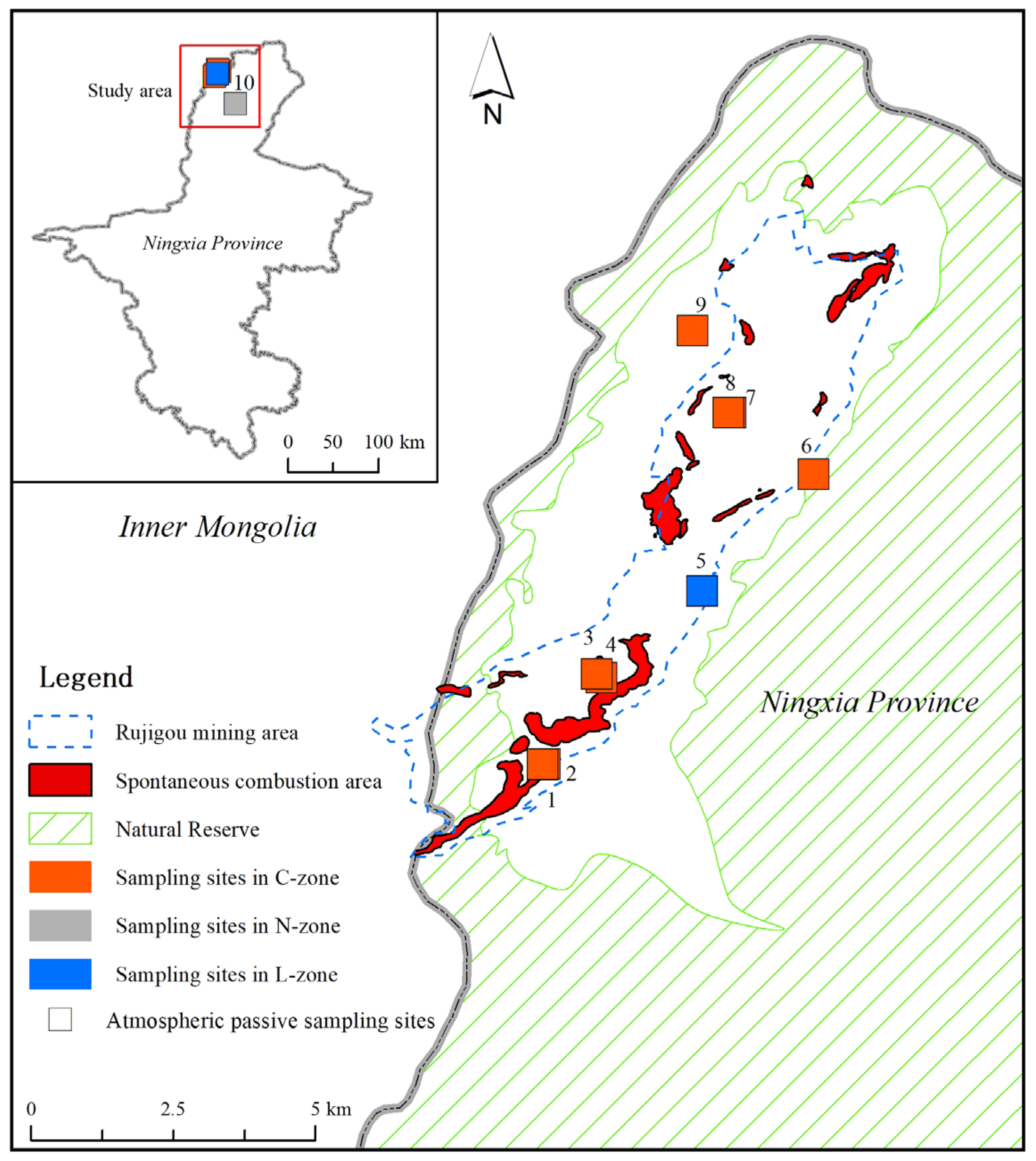

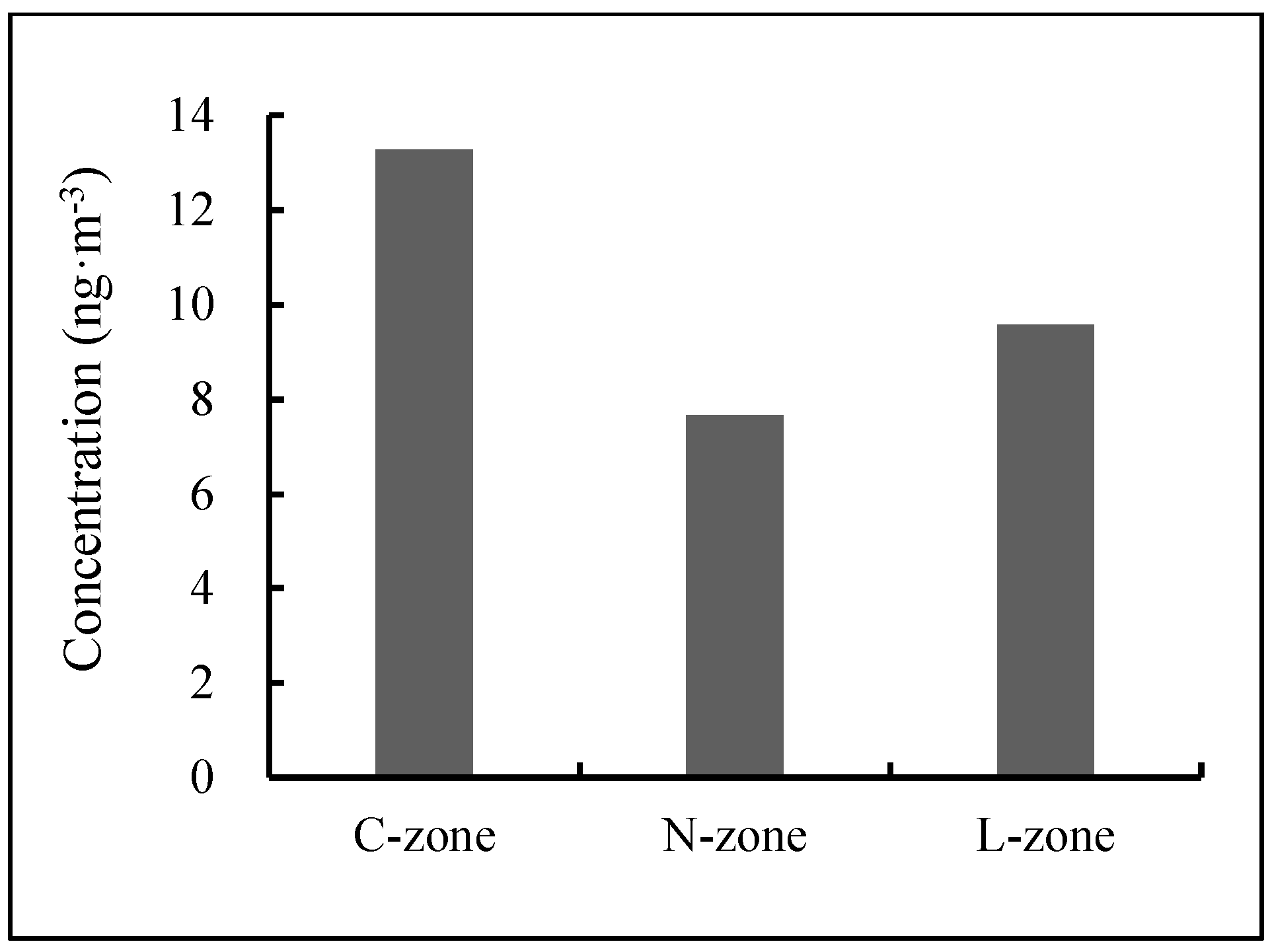
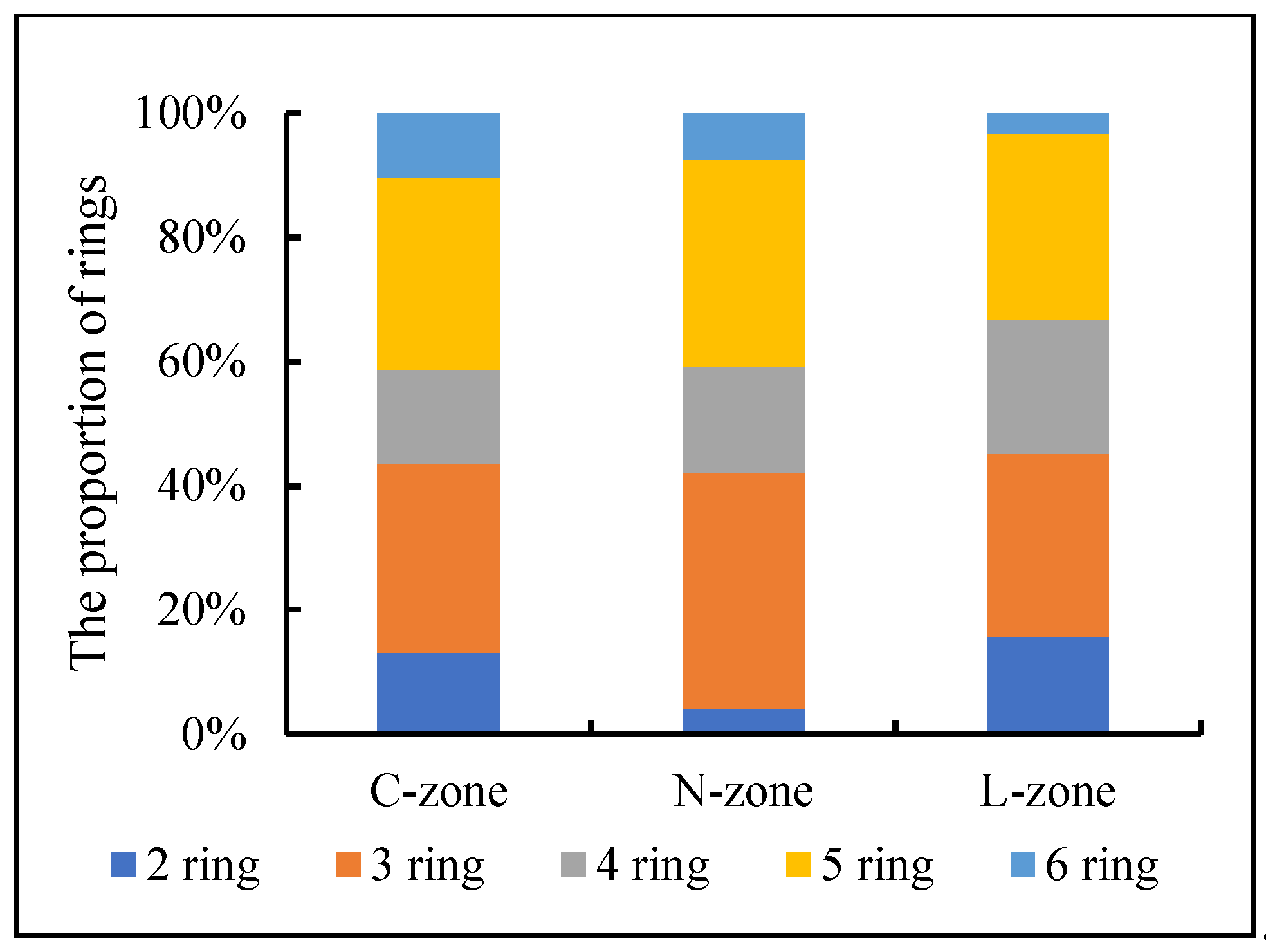
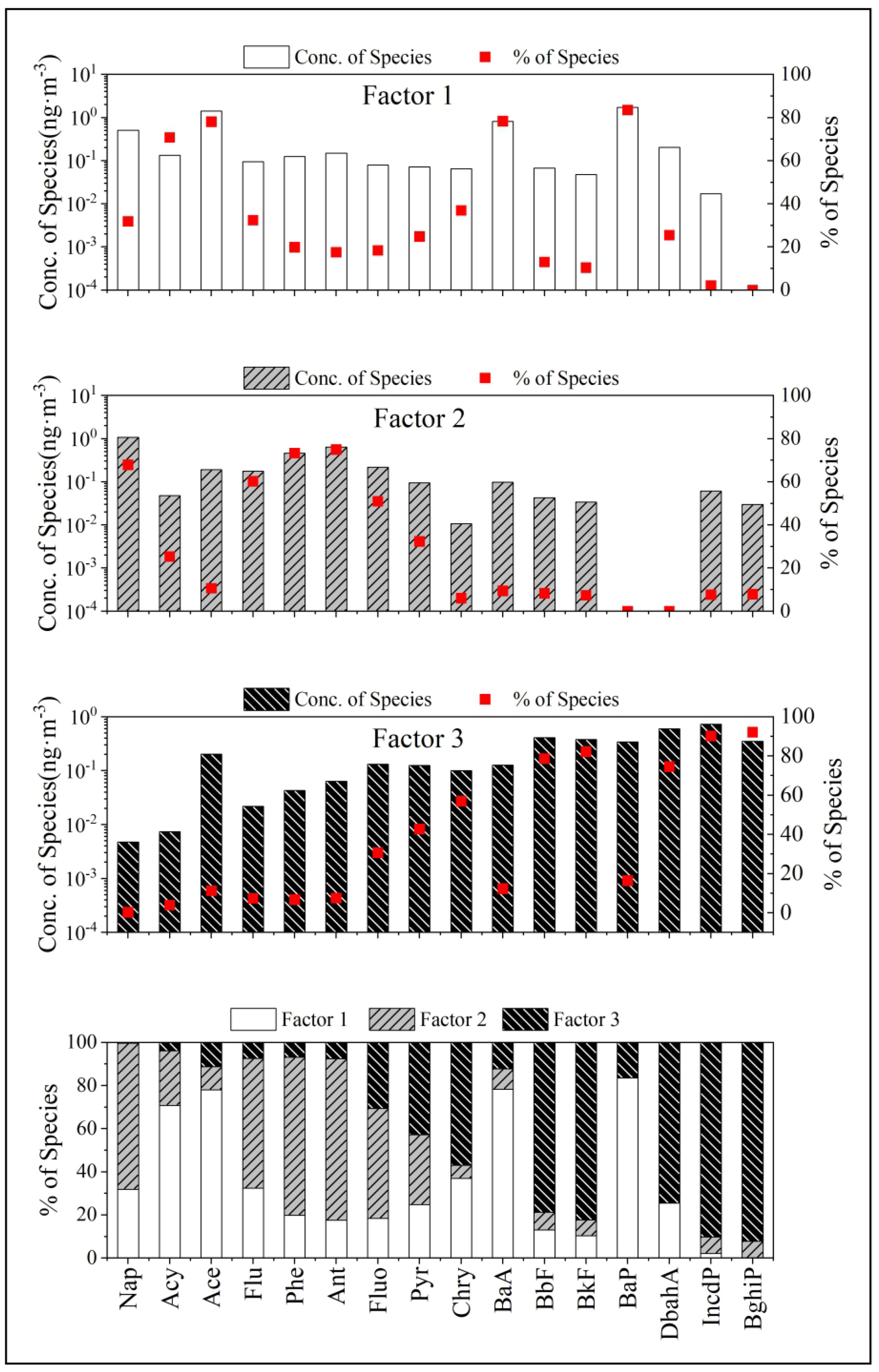
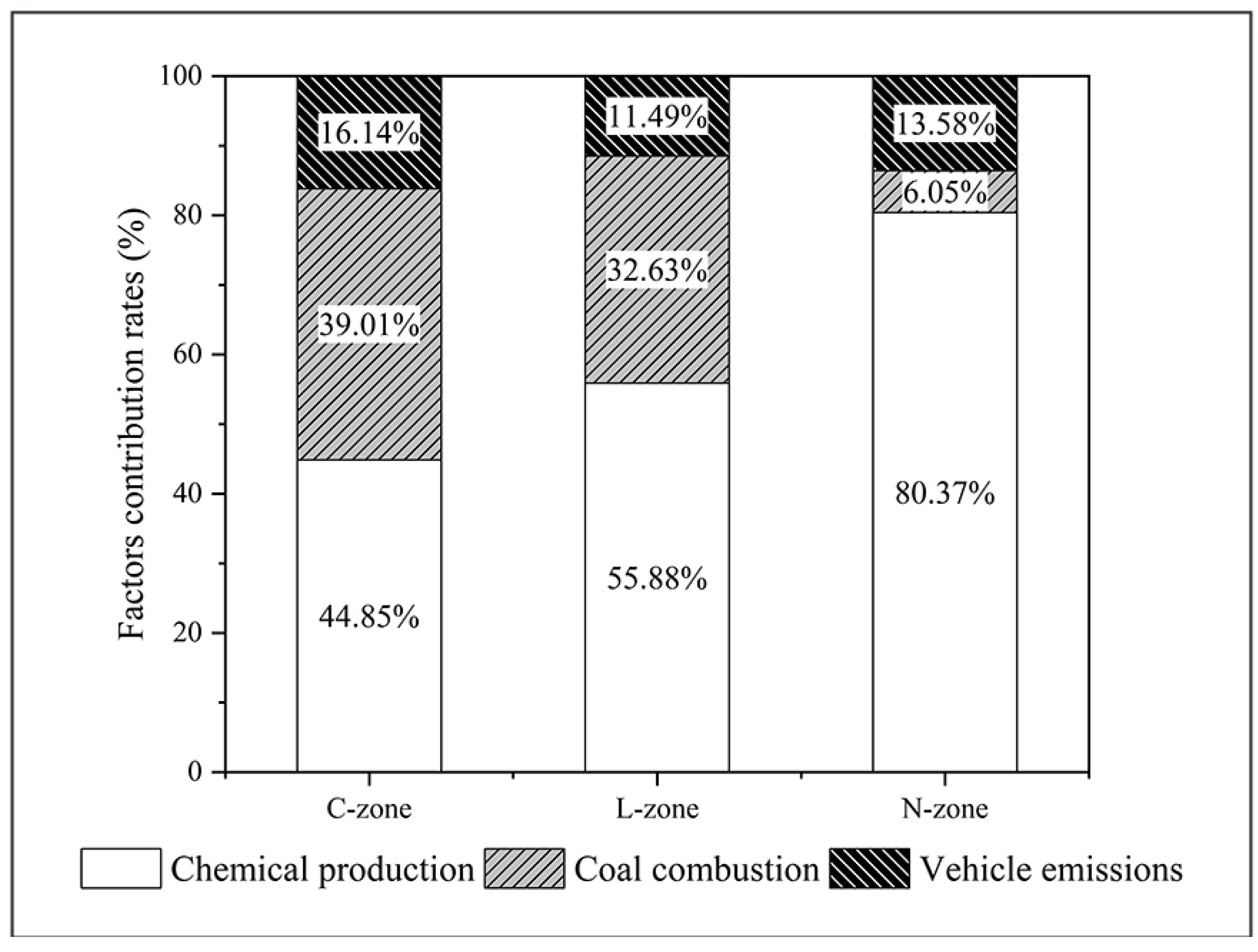
| C-Zone (N = 8) | N-Zone (N = 1) | L-Zone (N = 1) | |||||
|---|---|---|---|---|---|---|---|
| Min | Max | Mean | Median | S.D. 1 | |||
| Nap | 0.26 | 3.37 | 1.76 | 1.61 | 1.39 | 1.51 | 0.31 |
| Acy | 0.06 | 0.29 | 0.20 | 0.22 | 0.09 | 0.06 | 0.22 |
| Ace | 1.70 | 1.94 | 1.82 | 1.82 | 0.09 | 1.74 | 1.88 |
| Flu | 0.09 | 0.60 | 0.32 | 0.23 | 0.21 | 0.33 | 0.10 |
| Phe | 0.17 | 1.42 | 0.70 | 0.41 | 0.59 | 0.47 | 0.25 |
| Ant | 0.09 | 1.93 | 0.98 | 0.70 | 0.79 | 0.20 | 0.45 |
| Fluo | 0.07 | 1.34 | 0.48 | 0.41 | 0.43 | 0.41 | 0.07 |
| Pyr | 0.09 | 1.23 | 0.32 | 0.20 | 0.38 | 0.31 | 0.09 |
| Chry | 0.06 | 0.97 | 0.18 | 0.07 | 0.32 | 0.22 | 0.09 |
| BaA | 0.96 | 1.11 | 1.04 | 1.04 | 0.05 | 1.12 | 1.07 |
| BbF | 0.10 | 3.97 | 0.60 | 0.11 | 1.36 | 0.29 | 0.14 |
| BkF | 0.06 | 3.68 | 0.53 | 0.08 | 1.27 | 0.25 | 0.10 |
| BaP | 0.87 | 2.98 | 2.03 | 2.05 | 0.57 | 2.09 | 2.24 |
| DbahA | 0.11 | 5.75 | 0.91 | 0.19 | 1.96 | 0.24 | 0.53 |
| IncdP | 0.09 | 7.06 | 0.96 | 0.09 | 2.46 | 0.24 | 0.09 |
| BghiP | 0.04 | 3.42 | 0.46 | 0.04 | 1.20 | 0.08 | 0.04 |
Disclaimer/Publisher’s Note: The statements, opinions and data contained in all publications are solely those of the individual author(s) and contributor(s) and not of MDPI and/or the editor(s). MDPI and/or the editor(s) disclaim responsibility for any injury to people or property resulting from any ideas, methods, instructions or products referred to in the content. |
© 2023 by the authors. Licensee MDPI, Basel, Switzerland. This article is an open access article distributed under the terms and conditions of the Creative Commons Attribution (CC BY) license (https://creativecommons.org/licenses/by/4.0/).
Share and Cite
Yu, F.; Yu, Y.; Ai, N.; Gao, J.; Wang, C.; Huang, F. Compositional Difference and Health Risk Assessment of Polycyclic Aromatic Hydrocarbons over the Coal Spontaneous Combustion Zone. Atmosphere 2023, 14, 855. https://doi.org/10.3390/atmos14050855
Yu F, Yu Y, Ai N, Gao J, Wang C, Huang F. Compositional Difference and Health Risk Assessment of Polycyclic Aromatic Hydrocarbons over the Coal Spontaneous Combustion Zone. Atmosphere. 2023; 14(5):855. https://doi.org/10.3390/atmos14050855
Chicago/Turabian StyleYu, Feng, Yang Yu, Ning Ai, Juanqin Gao, Chenghui Wang, and Fan Huang. 2023. "Compositional Difference and Health Risk Assessment of Polycyclic Aromatic Hydrocarbons over the Coal Spontaneous Combustion Zone" Atmosphere 14, no. 5: 855. https://doi.org/10.3390/atmos14050855
APA StyleYu, F., Yu, Y., Ai, N., Gao, J., Wang, C., & Huang, F. (2023). Compositional Difference and Health Risk Assessment of Polycyclic Aromatic Hydrocarbons over the Coal Spontaneous Combustion Zone. Atmosphere, 14(5), 855. https://doi.org/10.3390/atmos14050855







